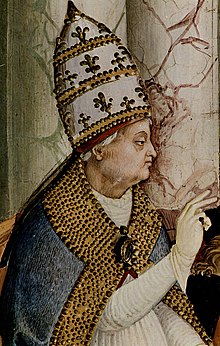Council of Mantua (1459)
The Council of Mantua in 1459 , or the Congress of Mantua , was called by Pope Pius II , who had been elected the previous year, to organize a war against the Ottomans , who had taken Constantinople in 1453 . He appealed to the rulers of Europe not to fight one another any more, but to unite against the common enemy of Christianity. The wars in northern Italy had just ended with the Peace of Lodi , but in England the Wars of the Roses and the Thirteen Years' War between the Prussian cities and the landed gentry against the Teutonic Order , whose support would have been decisive.
Course of the council
Pius II entered Mantua on May 27th and his long walk to the meeting place was like a procession. He opened the council on June 1st and awaited as a guest of Ludovico III. Gonzaga until September the representatives of the various rulers. On September 26th, he asked those present for a new crusade against the Ottomans. Cardinals Bessarion and Juan de Torquemada were present. Philip III of Burgundy was represented by the Duke of Clevès , who brought the young Burgundian cleric Ferry de Clugny with him. The humanist Isotta Nogarola wrote a speech in favor of the crusade and sent it to the Pope.
Not all church leaders were in favor of a crusade. The Venetian Cardinal Ludovico Trevisan , Patriarch of Aquileia , met Pius II on March 16 in Siena and followed him to Mantua, although he was against the convening of the Council.
When the council was dissolved in January 1460, an ineffective demand for a new crusade against the unbelievers had been resolved and announced by Pius on January 14th. One of the few European rulers who fully supported the crusade was Vlad III. even though he was too busy defending his homeland Wallachia to provide troops. Pius II tried to persuade the Christian princes to go on a crusade to free Constantinople. He died three years later in Ancona.
Council in Art

The painter Andrea Mantegna was in 1457 by Ludovico III. invited to Mantua: although he stayed in Padua , he painted for the mayor Orazione nell'orto (today in the National Gallery of London ): In the painting the apostles sleep in Gethsemane , while Jerusalem is depicted as Constantinople, on whose monuments now the Crescent moon stands, a sign of the conquest by the Ottomans.
It is believed that the flagellation of Christ by Piero della Francesca was a political manifesto to the Council of Mantua, recalling the agreement of the Council of Ferrara / Florence and showing an Orthodox Christ tortured by an unbeliever in the impotence of the Westerners . A few years after the Pope's death, Pinturicchio depicted the convening of the Council among the scenes from the life of Pius II in the Piccolomini library in the Siena Cathedral .
Tarot historians like Heinrich Brockhaus have stated that the so-called Mantegna Tarocchi was made during the council meetings.
attachment
- ^ Opening of the Mantua Congress. La Biblioteca Teresiana, accessed May 17, 2019 (Italian).
- ^ Salvador Miranda: The Cardinals of the Holy Roman Church. Ludovico Trevisano. 2018, accessed on May 17, 2019 .
- ^ Treptow, Kurt W .: Vlad III Dracula: the life and times of the historical Dracula . The Center for Romanian Studies, 2000, ISBN 973-98392-2-3 .
- ^ JH Whitfield: Mantegna and Constantinople (= The Burlington Magazine . No. 886 ). January 1977, p. 41 .
- ↑ Brockhaus, A noble game of patience: "The leadership of the world or the ladder to heaven", the so-called Taroks Mantegna .